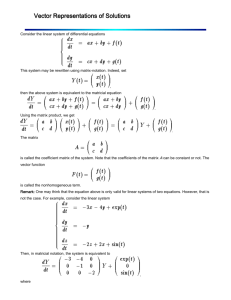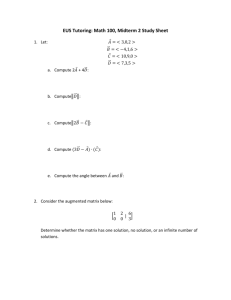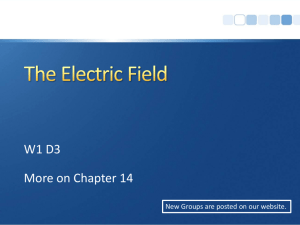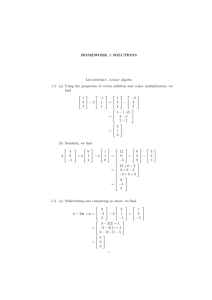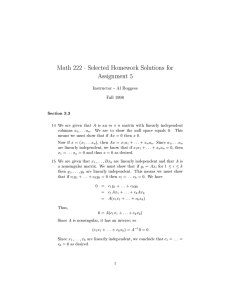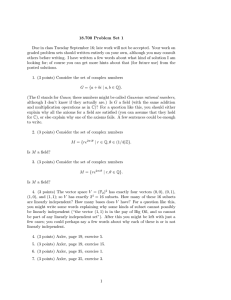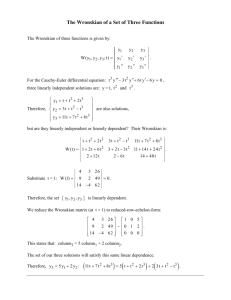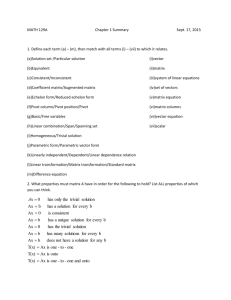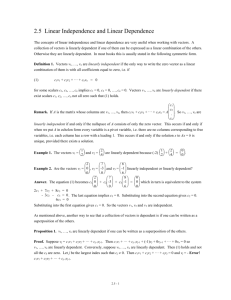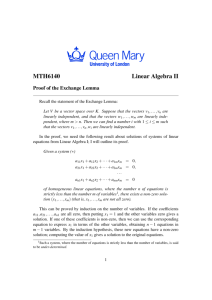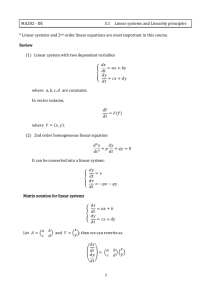1.3.10) Write a vector equation that is equivalent to the given system
advertisement
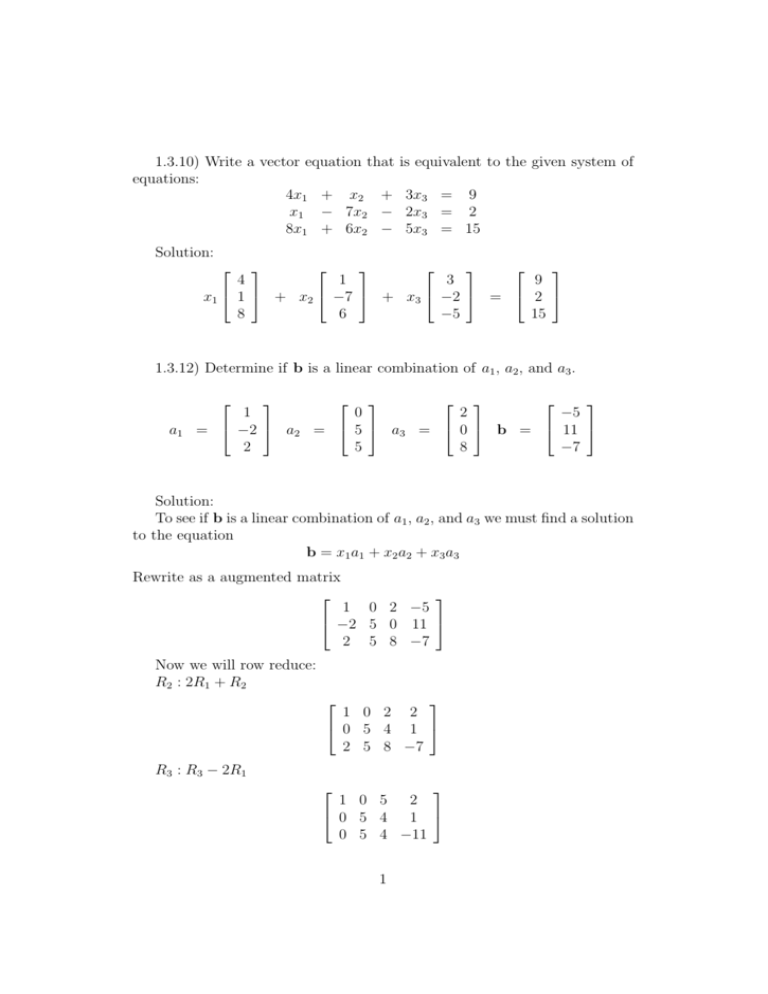
1.3.10) Write a vector equation that
equations:
4x1 + x2 +
x1 − 7x2 −
8x1 + 6x2 −
is equivalent to the given system of
3x3 = 9
2x3 = 2
5x3 = 15
Solution:
4
1
3
9
x1 1 + x2 −7 + x3 −2 = 2
8
6
−5
15
1.3.12) Determine if b is a linear combination of a1 , a2 , and a3 .
a1
1
0
2
−5
= −2 a2 = 5 a3 = 0 b = 11
2
5
8
−7
Solution:
To see if b is a linear combination of a1 , a2 , and a3 we must find a solution
to the equation
b = x 1 a1 + x 2 a2 + x 3 a3
Rewrite as a augmented matrix
1 0 2 −5
−2 5 0 11
2 5 8 −7
Now we will row reduce:
R2 : 2R1 + R2
1 0 2 2
0 5 4 1
2 5 8 −7
R3 : R3 − 2R1
1 0 5 2
0 5 4 1
0 5 4 −11
1
R3 : −R2 + R3
1 0 5 2
0 5 4 1
0 0 0 −12
Since 0 6= −12 we have that b is not a linear combination of a1 , a2 , and a3 .
2
0 6
10
1.3.26) Let A = −1 8 5 , let b = 3 , and let W be the set
1 −2 1
3
of all linear combinations of the columns of A.
a. Is b in W
b. Show that the third column of A is in W
Solution: a. First let
a1
2
0
6
−1
8
5
a2 =
a3 =
=
1
−2
1
We want to find x1 , x2 , and x3 such that
b = x 1 a1 + x 2 a2 + x 3 a3
As in 1.3.12 we will consider the Augmented matrix B = [a1 , a2 , a3 , b]
and row reduce. Now
2
0 6 10
B = −1 8 5 3
1 −2 1 3
R1 : (1/2)R1
1
0 3 5
−1 8 5 3
1 −2 1 3
R2 : R1 + R2
1 0 3 5
0 8 8 8
1 −2 1 3
2
R2 : (1/8)R2
R3 : R3 − R1
1 0
3
5
0 1
1
1
0 −2 −2 −2
R3 : R3 + 2R2
1 0 3 5
0 1 1 1
0 0 0 0
From this we can see that there are an infinite number of solutions. Let
x3 = t
Then
x3 = t
x2 = 1 − t
x2 = 5 − 3t
is a solution.
In particular if t = 0 we get
b = 5a1 + 1a2 + 0a3
b. a3 is in W since a3 =0a1 + 0a2 +1a3
1.3.30) Let v be the center of mass of a system of point masses located
at v1 , ..., vk as in Exercise 29. Is v in Span{v1 , ..., vk }?
Solution: From exercise 29 we know
v = (1/m)[m1 v1 + · · · + mk vk ]
where
m = m1 + · · · + mk
hence v is a linear combination
of
, ..., vk whichimplies
v1
v ∈ Span{v1 , ..., vk }.
7
3
6
1.4.26) Let u = 2 ,v = 1 , and w = 1 . It can be shown that
5
3
0
3u − 5v − w = 0. Use this fact to find x1 and x2 tat satisfy the equation
7 2
6
x1
2 1
= 1
x2
5 3
0
.
Solution:
3
3u − 5v − w = 0 implies 3u − 5v = w this gives
x1 = 3
x2 = −5
satisfy the equation.
1.5.6) Find the solution set to the homogeneous system
x1
+ 3x2 − 5x3 = 0
x1
+ 4x2 − 8x3 = 0
−3x1 − 7x2 + 9x3 = 0
Solution:
Let A be the matrix
of coefficients of the system and row reduce the
augmented matrix A 0 to echelon form
1
3 −5 0
1
4 −8 0
−3 −7 9 0
R2 : R2 − R1
R3 : R3 + 3R1
1 3 −5 0
0 1 −3 0
0 2 −6 0
R1 : R1 − 3R2
R3 : R3 − 2R1
1 0 4 0
0 1 −3 0
0 0 0 0
Since x3 is a free variable we have nontrival solutions.
Our Solutions are:
x3 = t
x2 = 3t
x1 = −4t
1.5.26) Suppose Ax = b has a solution. Explain why the solution is
unique precisely when Ax = 0 has only the trivial solution.
Solution: Suppose Ax = 0 has only the trivial solution, and assume a1
and a2 are solutions to Ax = b. We will show a1 = a2 . By assumption we
have Aa1 = b and Aa2 = b. By Theorem 1.4.5 we have
A(a1 − a2 ) = Aa1 − Aa2 = b − b = 0
4
Hence a1 − a2 is a solution to Ax = 0. So by assumption a1 − a2 = 0 or
a1 = a2 . Hence Ax = b has a unique solution.
Suppose Ax = b has a unique solution say a, and let c be a solution to
Ax = 0. Then by Theorem 1.4.5 we have
A(a + c) = Aa + Ac = b + 0 = b
Hence a + c is a solution to Ax = b and since we assumed that a was a
unique solution to Ax = b we must have a + c = a or c = 0. Hence Ax = 0
has only the trivial solution.
1.7.6) Determine if the columns of the matrix A form a linearly independent set, where
−4 −3 0
0 −1 4
A=
1
0 3
5
4 6
Solution: We know from the chapter that the columns of a matrix A are
linearly independent if and only if the equation Ax = 0 has only the trivial
solution. So we will row reduce the augmented matrix
−4 −3 0 0
0 −1 4 0
B=
1
0 3 0
5
4 6 0
R1 ↔ R2
R2 : −R2
1
0
3 0
0
1 −4 0
−4 −3 0 0
5
4
6 0
R3 : R3 + 4R1
R4 : R4 − 5R1
1 0
3
0 1 −4
0 −3 12
0 4 −9
R3 : R3 + 3R2
R4 : R4 − 4R1
5
0
0
0
0
1
0
0
0
0 3 0
1 −4 0
0 0 0
0 7 0
From here we can see Ax = 0 has only the trivial solution, hence the
columns of A are linearly independent.
1.7.16) Determine whether the vectors are linearly independent.
4
6
−2 , −3
6
9
Solution:
4
6
−2 = (2/3) −3
6
9
So the vectors are linearly dependent.
1.7.36) If v1 , . . . , v4 are in R4 and v3 is not a linear combination of
v1 , v2 , v4 , then {v1 , . . . , v4 } is linearly independent.
Solution: False.
4
Let v1 = v2 = v4 = 0 and v3 = −2
6
The any linear combination of v1 , v2 , v4 is the 0 vector hence v3 6∈
Span{v1 , v2 , v4 } but v1 , . . . , v4 is not linearly independent by theorem 9
since it contains the zero vector.
6
